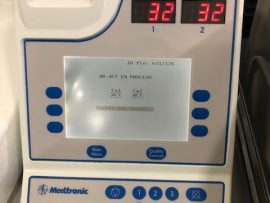Abstract Background Bleeding is a common and sometimes fatal complication of venovenous extracorporeal membrane oxygenation (ECMO). Whether lowering the intensity of anticoagulation during venovenous ECMO is safe or effective is..
Read MoreAbstract The 2021 Adult and Pediatric Anticoagulation Guidelines for patients on extracorporeal membrane oxygenation (ECMO) recommend a target partial thromboplastin time (PTT) between 60 and 85 seconds when unfractionated heparin..
Read MoreAbstract Artificial organs, such as extracorporeal membrane oxygenators, dialyzers, and hemoadsorber cartridges, face persistent challenges related to the flow distribution within the cartridge. This uneven flow distribution leads to clot..
Read MoreAbstract Introduction Lung transplantation has been evolving since its inception in 1963. Over recent years, literature has suggested a shift in the perioperative strategy of mechanical support toward extracorporeal membrane..
Read MoreAbstract Extracorporeal membrane oxygenation (ECMO), the key component of which is a membrane oxygenator, known as the artificial lung, could provide irreplaceable respiratory support for patients with cardiopulmonary failure. The..
Read MoreAbstract Introduction During extracorporeal membrane oxygenation (ECMO) systemic anticoagulation with unfractionated heparin (UFH) is standard-of-care. However, there is uncertainty regarding optimal anticoagulation monitoring strategies. Methods We retrospectively investigated venovenous and..
Read MoreIntroduction Extracorporeal Membrane Oxygenation (ECMO) has revolutionized the management of patients with severe cardiac and respiratory failure. Once considered a last-resort therapy, ECMO is now an integral part of critical..
Read MoreIntroduction Cardiopulmonary bypass (CPB) is a life-saving technology that temporarily replaces the heart and lungs during cardiac surgery. The choice of priming solution plays a crucial role in maintaining hemodynamic..
Read MoreIntroduction Isolated Limb Perfusion (ILP) is a targeted chemotherapy technique used primarily for treating locally advanced limb malignancies, such as soft tissue sarcomas and melanoma. By isolating the limb’s vascular..
Read MoreLeft Heart Bypass: An Overview Introduction Left Heart Bypass (LHB) is a surgical technique used to temporarily divert blood from the left side of the heart to maintain distal perfusion..
Read MoreCardiopulmonary bypass (CPB) is a cornerstone of modern cardiac surgery, enabling complex procedures by temporarily taking over the heart and lung functions. However, one of the most critical aspects of..
Read MorePerfusionists play a critical role in cardiac surgery and extracorporeal support, ensuring optimal oxygenation and circulation during procedures. However, given the complexity of the field, even experienced professionals can make..
Read MoreAbstract Extracorporeal perfusion systems utilized in open-heart surgeries with cardiopulmonary bypass can affect multiple body systems. The primary adverse effects of Extracorporeal Perfusion Systems (EPS) on the hematological system include..
Read MoreAbstract Contact of blood with artificial surfaces triggers platelet activation. The aim was to compare platelet kinetics after venovenous extracorporeal membrane oxygenation (V-V ECMO) start and after system exchange in..
Read MoreAbstract In blood extracorporeal circulations such as hemodialysis (HD) and extracorporeal membrane artificial lung (ECMO) during the surgical operation, the real-time and noninvasive prediction of heparin concentration c is necessary over the..
Read MoreAbstract This study presents the utilization of a novel, highly lipophilic nitric oxide (NO) donor molecule, S-nitroso-1-adamantanethiol (SNAT), for developing an NO-emitting polymer surface aimed at preventing thrombus formation and bacterial..
Read MoreAbstract The blood vessel network transfers gas and nutrients throughout the body. In addition, vascular cells contribute to essential functions such as coagulation, immune regulation, angiogenesis and tissue repair, and..
Read MoreAndexanet Alfa–Associated Heparin Resistance in Cardiac Surgery: Mechanism and In Vitro Perspectives
Abstract BACKGROUND: Andexanet alfa (andexanet) is the only Food and Drug Administration–approved antidote for direct FXa (factor Xa) inhibitors but has been reported to cause resistance to unfractionated heparin (UFH)...
Read MoreAbstract Intraoperative cell salvage (IOCS) allows the collection, treatment, and retransfusion of shed blood from the surgical field and cardiopulmonary bypass (CPB) collector during cardiac surgery. This technique has been..
Read MoreAbstract Background Cardiac surgery patients are at increased risk for venous thromboembolism (VTE). Prevention is the most critical strategy to reduce VTE-associated morbidity and death. However, there is a lack..
Read MoreAbstract Introduction There is no consensus on the dose of heparin to be used intraoperatively in cardiac myxomas, so the goal of this study was to look into the differences..
Read MoreAbstract Coronary artery bypass grafting (CABG) with cardiopulmonary bypass (CPB) is associated with the transient activation of a systemic inflammatory response. Fibronectin (FN), an endogenous inflammatory mediator, is a key..
Read MoreAbstract Background: Monitoring the anticoagulant effect of unfractionated heparin (UFH) in extracorporeal membrane oxygenation (ECMO) patients is complex but critically important to balance the risks of treatment related bleeding and..
Read MoreAbstract Extracorporeal cardiopulmonary resuscitation (ECPR) is a complex, life-saving procedure that uses mechanical support for patients with refractory cardiac arrest, representing the pinnacle of extracorporeal membrane oxygenation (ECMO) applications. Effective..
Read MoreAbstract Objective To document the experience with ECMO therapy in healthcare institutions across Latin America between 2016 and 2020. Design Cross-sectional study. Setting Private and public health institutions from 7..
Read MoreAbstract The term heparin resistance is likely best defined as the failure of an appropriate dose of unfractionated heparin (UFH) to achieve a predetermined level of anticoagulation. Unfortunately, and despite..
Read MoreAbstract Purpose of review Circulatory and respiratory support with extracorporeal membrane oxygenation (ECMO) has gained widespread acceptance during high-end thoracic surgery. The purpose of this review is to summarize the..
Read MoreAbstract Background Extracorporeal membrane oxygenation (ECMO) is mainly used for support of patients with cardiopulmonary collapse. The increasing use of ECMO has shown promising outcomes; however, it still carries the..
Read MoreAbstract Extracorporeal Membrane Oxygenation (ECMO) has become an essential lifesaving intervention for individuals with severe cardiovascular and respiratory failure. Its application is expanding across several therapeutic contexts, surpassing conventional indications...
Read MoreAnticoagulation management during veno-venous ECMO support because of ARDS: Single-center experience
Abstract Background Patients with severe acute respiratory distress syndrome (ARDS) show a high mortality rate of up to 60 %. In such cases, extracorporeal membrane oxygenation (ECMO) support is often required,..
Read More
















